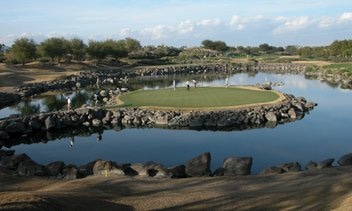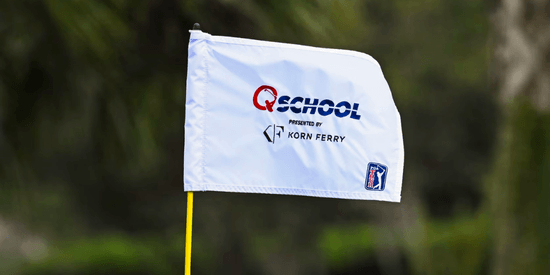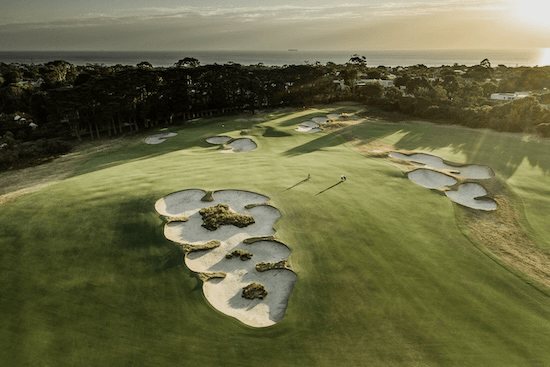PGA West Course Review: 25 years of spectacular golf
3/30/2011 | by
see also: PGA West - Stadium Course, All Course Reviews

Famous designer Pete Dye's work of art at the TPC Stadium Course is still challenging golfers after 25 years.
LA QUINTA — In the early 1980s Ernie Vossler
and his partners with Landmark Golf
commissioned architect Pete Dye to transform
farmland 30 miles east of Palm
Springs into
one of the most diabolical golf tests on earth.
It was to be called the TPC Stadium Course, and it was meant to put a burgeoning real estate development, PGA West, on the national map.
At the time, Dye had become America’s “it” designer following the 1980 debut of the Tournament Players Club in Ponte Vedra, Fla. – the first of numerous “stadium” designs in the country.
The players of the PGA Tour were already wailing about the brutality of the TPC, to which Dye famously replied, “Golf is not a fair game, so why build a course fair?”
Still, when Vossler, a former tour player, got his first gander at the PGA West Stadium Course’s 16th hole – with its two-story high bunker nearly surrounding the green – he thought Dye had gone off the sadistic deep end.
Vossler asked Dye to tone it down. The man dubbed the “Marquis de Sod” refused. So they made a bet. If Dye could put one shot from the cavernous bunker, 20 feet deep, within 10 feet of the pin in three tries, the crater would go untouched.
Dye, in his 60s at the time, required only one attempt, hitting a floater to 2 feet.
Vossler is said to have turned and walked away without a word, and PGA West had the first of a thousand tales to tell.
The 25th anniversary of the opening of the Stadium Course is being celebrated this month, and there is no doubt that the famous layout and its surrounding community of 4,000 homes have had a long-lasting impact on golf in Southern California and the U.S.
“It’s clearly one of the most iconic brands as a golf destination – and that’s not just drinking the Kool-Aid,” said Mike Kelly, PGA West’s executive director of golf.
The self-proclaimed “Western Home of Golf in America” now features six courses – three public and three private – and is owned by Morgan Stanley, which also operates the La Quinta Resort and Club and its three courses. That’s nine pristine layouts within minutes of each other, set in spectacular scenery at the foot of the Santa Rosa Mountains.
Even non-golfers will recognize the designers of the nine courses: Dye (three), Jack Nicklaus (two), Arnold Palmer (two), Greg Norman and Tom Weiskopf.
“There are individual better courses,” Kelly said. “But I don’t think you can find a better collection of designers and a better collection of courses under one umbrella.”
The Stadium Course is the track that golfers love to hate or hate to love. It hosts the PGA Tour’s Qualifying School every two years and the tee sheets are often full, owing to the masochists who shell out $229 in prime season to play holes dubbed The Sand Pit, Alcatraz and Amen. The 16th hole and its infamous bunker? They call it San Andreas Fault.
Golf Digest ranked the Stadium Course as the fourth-toughest in America in 2007. You think Torrey Pines South is a brute? From the back tees, the Stadium is rated two strokes harder (76.1 to 74.1) by the Southern California Golf Association.
There are 5,000 railroad ties, waste bunkers 200 yards long, water on nine holes, and pot bunkers strewn everywhere. Dye called it the “grenade attack look.” It’s the golfers who frequently explode.
The late Jim Murray once wrote of the Stadium, “"You need a camel, a canoe, a priest and a tourniquet to get through it."
From the time of the Stadium’s opening, it took only a few months for it to become famous, and only another few months to attract infamy.
The Stadium hosted the 1986 Skins Game only seven months after Nicklaus won the Masters at age 46. A year later in the Skins, it was Lee Trevino who would produce the Stadium’s most famous shot, a 6-iron hole-in- one at the island 17th named Alcatraz. It would be the only ace in 26 editions of the Skins.
Trevino’s thrill that year came after the rank- and-file PGA Tour pros were livid at having to play the Stadium for the first time in the 1987 Bob Hope rotation. After they’d averaged more than 74 strokes, 50 players voted in a closed-door meeting to strike the course from the event.
“They condemned it, and I was sick,” Dye said in a 2006 interview.
The tour caved and moved to the Palmer Private Course – where the tournament is still played and where David Duval shot 59 to win the ’99 Hope.
Fifty-nine? For the average hack, that’s a nine worth celebrating on the Stadium.
IF YOU GO
La Quinta Resort & Club
Opened in 1926, the La Quinta Resort is a member of Hilton’s Waldorf Astoria Collection. Amid some of the most beautiful surroundings in all of Southern California, it features 20 hacienda-style casitas and 796 guestrooms and villas. One of the key features at La Quinta is that there is a pool around nearly every corner – 41 of them in all. There also are 53 hot spas, 23 championship tennis courts, a shopping plaza, spa and fitness facilities, and three restaurants.
Golf courses
A look at the five public golf courses at PGA West and La Quinta:
PGA West TPC Stadium Course
It easily lives up to its reputation for being a brutal for an average golfer, but it has some unforgettable shot requirements, and if you pull off just one, it’s a lifetime memory. Green fees: $79-$229.
PGA West Nicklaus Tournament Course
Forgiving off the tee and demanding around the greens, this course joins the Stadium in hosting the PGA Tour Qualifying School every two years. It also has hosted the PGA Tour Grand Slam and Diners Club Matches. Green fees: $59-$205.
PGA West Norman Course
Aussie Greg Norman delivered an “outback” experience by designing a target-style course that has only 68 acres of turf and nine lakes. There is sand, sand everywhere, including 102 crushed white marble bunkers. The 11th hole is only 300 yards from the blues and has 15 bunkers! Green fees: $59-$205.
La Quinta Mountain Course
Forgiving for a Pete Dye design, this may also be the most beautiful course among the five. It has numerous holes set against the mountain and the final stretch is spectacular. A must-play course on any visit. Green fees: $59-$205.
La Quinta Dunes Course
A Dye design that has been reworked recently, this is a links-style course with Scottish and Irish flair. There’s plenty of bump-and-run golf to be played, and there are a lot of railroad ties and water, too. Green fees: $49- $165.
On the web
La Quinta Resort: laquintaresort.com
PGA West: pgawest.com
It was to be called the TPC Stadium Course, and it was meant to put a burgeoning real estate development, PGA West, on the national map.
At the time, Dye had become America’s “it” designer following the 1980 debut of the Tournament Players Club in Ponte Vedra, Fla. – the first of numerous “stadium” designs in the country.
The players of the PGA Tour were already wailing about the brutality of the TPC, to which Dye famously replied, “Golf is not a fair game, so why build a course fair?”
Still, when Vossler, a former tour player, got his first gander at the PGA West Stadium Course’s 16th hole – with its two-story high bunker nearly surrounding the green – he thought Dye had gone off the sadistic deep end.
Vossler asked Dye to tone it down. The man dubbed the “Marquis de Sod” refused. So they made a bet. If Dye could put one shot from the cavernous bunker, 20 feet deep, within 10 feet of the pin in three tries, the crater would go untouched.
Dye, in his 60s at the time, required only one attempt, hitting a floater to 2 feet.
Vossler is said to have turned and walked away without a word, and PGA West had the first of a thousand tales to tell.
The 25th anniversary of the opening of the Stadium Course is being celebrated this month, and there is no doubt that the famous layout and its surrounding community of 4,000 homes have had a long-lasting impact on golf in Southern California and the U.S.
“It’s clearly one of the most iconic brands as a golf destination – and that’s not just drinking the Kool-Aid,” said Mike Kelly, PGA West’s executive director of golf.
The self-proclaimed “Western Home of Golf in America” now features six courses – three public and three private – and is owned by Morgan Stanley, which also operates the La Quinta Resort and Club and its three courses. That’s nine pristine layouts within minutes of each other, set in spectacular scenery at the foot of the Santa Rosa Mountains.
Even non-golfers will recognize the designers of the nine courses: Dye (three), Jack Nicklaus (two), Arnold Palmer (two), Greg Norman and Tom Weiskopf.
“There are individual better courses,” Kelly said. “But I don’t think you can find a better collection of designers and a better collection of courses under one umbrella.”
The Stadium Course is the track that golfers love to hate or hate to love. It hosts the PGA Tour’s Qualifying School every two years and the tee sheets are often full, owing to the masochists who shell out $229 in prime season to play holes dubbed The Sand Pit, Alcatraz and Amen. The 16th hole and its infamous bunker? They call it San Andreas Fault.
Golf Digest ranked the Stadium Course as the fourth-toughest in America in 2007. You think Torrey Pines South is a brute? From the back tees, the Stadium is rated two strokes harder (76.1 to 74.1) by the Southern California Golf Association.
There are 5,000 railroad ties, waste bunkers 200 yards long, water on nine holes, and pot bunkers strewn everywhere. Dye called it the “grenade attack look.” It’s the golfers who frequently explode.
The late Jim Murray once wrote of the Stadium, “"You need a camel, a canoe, a priest and a tourniquet to get through it."
From the time of the Stadium’s opening, it took only a few months for it to become famous, and only another few months to attract infamy.
The Stadium hosted the 1986 Skins Game only seven months after Nicklaus won the Masters at age 46. A year later in the Skins, it was Lee Trevino who would produce the Stadium’s most famous shot, a 6-iron hole-in- one at the island 17th named Alcatraz. It would be the only ace in 26 editions of the Skins.
Trevino’s thrill that year came after the rank- and-file PGA Tour pros were livid at having to play the Stadium for the first time in the 1987 Bob Hope rotation. After they’d averaged more than 74 strokes, 50 players voted in a closed-door meeting to strike the course from the event.
“They condemned it, and I was sick,” Dye said in a 2006 interview.
The tour caved and moved to the Palmer Private Course – where the tournament is still played and where David Duval shot 59 to win the ’99 Hope.
Fifty-nine? For the average hack, that’s a nine worth celebrating on the Stadium.
IF YOU GO
La Quinta Resort & Club
Opened in 1926, the La Quinta Resort is a member of Hilton’s Waldorf Astoria Collection. Amid some of the most beautiful surroundings in all of Southern California, it features 20 hacienda-style casitas and 796 guestrooms and villas. One of the key features at La Quinta is that there is a pool around nearly every corner – 41 of them in all. There also are 53 hot spas, 23 championship tennis courts, a shopping plaza, spa and fitness facilities, and three restaurants.
Golf courses
A look at the five public golf courses at PGA West and La Quinta:
PGA West TPC Stadium Course
It easily lives up to its reputation for being a brutal for an average golfer, but it has some unforgettable shot requirements, and if you pull off just one, it’s a lifetime memory. Green fees: $79-$229.
PGA West Nicklaus Tournament Course
Forgiving off the tee and demanding around the greens, this course joins the Stadium in hosting the PGA Tour Qualifying School every two years. It also has hosted the PGA Tour Grand Slam and Diners Club Matches. Green fees: $59-$205.
PGA West Norman Course
Aussie Greg Norman delivered an “outback” experience by designing a target-style course that has only 68 acres of turf and nine lakes. There is sand, sand everywhere, including 102 crushed white marble bunkers. The 11th hole is only 300 yards from the blues and has 15 bunkers! Green fees: $59-$205.
La Quinta Mountain Course
Forgiving for a Pete Dye design, this may also be the most beautiful course among the five. It has numerous holes set against the mountain and the final stretch is spectacular. A must-play course on any visit. Green fees: $59-$205.
La Quinta Dunes Course
A Dye design that has been reworked recently, this is a links-style course with Scottish and Irish flair. There’s plenty of bump-and-run golf to be played, and there are a lot of railroad ties and water, too. Green fees: $49- $165.
On the web
La Quinta Resort: laquintaresort.com
PGA West: pgawest.com
Most Popular Articles

2025 PGA TOUR Q-School Guide: Sites, Scores, and Who Advanced
Dec 5, 2025Second Stage is complete and Final Stage awaits at Sawgrass — follow every Q-School leaderboard and the players still chasing
2025 LPGA TOUR Q-Series: Final Qualifying Stage FINAL SCORING
Dec 8, 2025Helen Briem earns medalist honors, 31 players headed to the LPGA next year
Australian Open at Royal Melbourne: Preview, amateur bios, and how to watch
Nov 30, 2025Rory McIlroy headlines one of the championship's top fields in years - at least four amateurs will have their chance at glory
Luke Ringkamp Cruises to Rolex Tournament of Champions Title at TPC San Antonio
Nov 26, 2025One week after committing to Pepperdine, Luke Ringkamp won the Rolex Tournament of Champions by nine shots.Inside Gil Hanse’s Restoration of Baltusrol’s Upper Course: A Return to Tillinghast’s
Dec 11, 2025Renowned architect Gil Hanse reveals how he brought Baltusrol’s Upper Course back to life by honoring A.W. Tillinghast’s originalLoading latest news...
